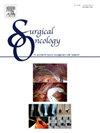横波弹性成像联合高频超声预测对侧或单侧甲状腺乳头状癌隐匿性癌的存在
IF 2.4
4区 医学
Q3 ONCOLOGY
引用次数: 0
摘要
目的探讨单侧叶乳头状甲状腺癌(PTC)和对侧叶隐匿性甲状腺癌(PTC)的高频超声(US)征象与剪切波弹性成像(SWE)参数的相关性,评价超声联合高频超声(SWE)术前预测对侧甲状腺隐匿性癌的价值,为临床医生术前手术入路选择提供帮助。方法收集552例术前诊断为单侧甲状腺癌,术后病理证实为PTC的患者。术前进行高频超声和超声。根据病理结果分为对侧隐匿性PTC阳性组和阴性组。通过单因素和多因素分析,探讨单侧PTC的超声表现与对侧隐匿性癌的关系,并比较单高频超声、单SWE、SWE联合高频超声预测对侧隐匿性PTC的准确性。结果单因素分析显示,两组患者甲状腺外展(ETE)、同侧多灶性、合并桥本甲状腺炎(HT)、合并淋巴结转移、原发肿瘤Emax、Emean值差异均有统计学意义(P <;0.05)。多因素logistic回归模型显示,两组间甲状腺外展、同侧多灶性、淋巴结转移、HT和高Emax值的差异均为对侧隐匿性PTC的独立预测因子。ROC曲线分析显示高频超声与SWE预测对侧隐匿性PTC的AUC差异无统计学意义(0.739 vs 0.699,P = 0.185)。高频超声联合SWE预测对侧隐匿性PTC的AUC显著高于单独使用高频超声和SWE预测的AUC (0.794 vs 0.739, P = 0.005;0.794 vs 0.699,P <;结论swe联合高频超声提高了对侧隐匿性PTC的预测,在甲状腺单侧病变甲状腺外展、同侧多灶性、颈部淋巴结转移、Emax高、HT联合的情况下,对侧隐匿性PTC更容易出现。本文章由计算机程序翻译,如有差异,请以英文原文为准。
Shear wave elastography combined with high-frequency ultrasound for predicting the presence of occult carcinoma contralateral to unilateral papillary thyroid cancer
Objective
To investigate the correlation between high-frequency ultrasound (US) signs and shear wave elastography (SWE) parameters of papillary thyroid carcinoma (PTC) in a unilateral lobe and the contralateral lobe occult PTC, and to evaluate the value of SWE in combination with high-frequency US in predicting contralateral occult carcinoma of the thyroid gland preoperatively, to provide clinicians with assistance in the selection of preoperative surgical approaches.
Methods
We collected a total of 552 preoperatively diagnosed patients with unilateral thyroid carcinoma and postoperatively pathologically confirmed PTC. High-frequency US and SWE were performed before surgery. Based on the pathologic findings, they were divided into the contralateral occult PTC positive group and the negative group. To investigate the association between the ultrasonographic features of unilateral PTC and the presence of contralateral occult carcinoma by univariate and multivariate analyses, and comparing the accuracy of high-frequency US alone, SWE alone, and SWE combined with high-frequency US in predicting contralateral occult PTC.
Results
Univariate analysis showed that the differences between the two groups of extrathyroidal extension (ETE), ipsilateral multifocality, the combination of Hashimoto's thyroiditis (HT), the combination of lymph node metastasis, and Emax and Emean values of the primary tumors were statistically significant (P < 0.05). The multifactorial binary logistic regression model showed that the differences between the two groups of extrathyroidal extension, ipsilateral multifocality, lymph node metastasis, HT and high Emax value were all independent predictors of contralateral occult PTC. The ROC curve analysis showed no statistically significant difference between high-frequency ultrasound and SWE in predicting the AUC of contralateral occult PTC (0.739 vs 0.699,P = 0.185). The AUC for predicting contralateral occult PTC using high-frequency US combined with SWE was significantly higher than the AUC predicted using high-frequency US and SWE alone (0.794 vs 0.739, P = 0.005; 0.794 vs 0.699,P < 0.001)
Conclusion
SWE combined with high-frequency US improves the prediction of contralateral occult PTC, and the presence of contralateral occult PTC is more likely in the presence of extrathyroidal extension of a unilateral lobe lesion of the thyroid gland, ipsilateral multifocality, metastasis to cervical lymph nodes, high Emax, and the combination of HT.
求助全文
通过发布文献求助,成功后即可免费获取论文全文。
去求助
来源期刊

Surgical Oncology-Oxford
医学-外科
CiteScore
4.50
自引率
0.00%
发文量
169
审稿时长
38 days
期刊介绍:
Surgical Oncology is a peer reviewed journal publishing review articles that contribute to the advancement of knowledge in surgical oncology and related fields of interest. Articles represent a spectrum of current technology in oncology research as well as those concerning clinical trials, surgical technique, methods of investigation and patient evaluation. Surgical Oncology publishes comprehensive Reviews that examine individual topics in considerable detail, in addition to editorials and commentaries which focus on selected papers. The journal also publishes special issues which explore topics of interest to surgical oncologists in great detail - outlining recent advancements and providing readers with the most up to date information.
 求助内容:
求助内容: 应助结果提醒方式:
应助结果提醒方式:


